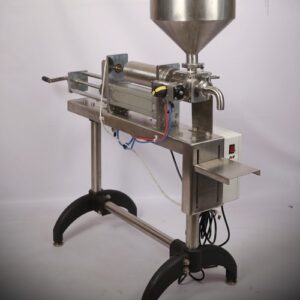Description
| Specification | Description |
|---|---|
| Model | Dual Heads Volumetric Piston Filler |
| Number of Heads | 2 |
| Filling Volume Range | 50ml – 1000ml (customizable upon request) |
| Filling Accuracy | ± 0.5% (depending on product characteristics) |
| Material | Stainless Steel AISI 304/316 |
| Power Supply | 220V/380V, 50/60Hz (customizable upon request) |
| Air Pressure | 0.6 – 0.8 MPa |
| Air Consumption | 0.6 – 0.8 m³/min |
| Control System | PLC with Touch Screen Interface |
| Filling Speed | Adjustable, up to 60 fills per minute (per head) |
| Dimensions (L x W x H) | Customizable based on production line layout |
| Weight | Varies depending on configuration and capacity |
| Optional Features | CIP (Clean-in-Place) System, Nozzle Diving |
| Certification | CE Certified |
| Warranty | 1-Year Limited Warranty |



